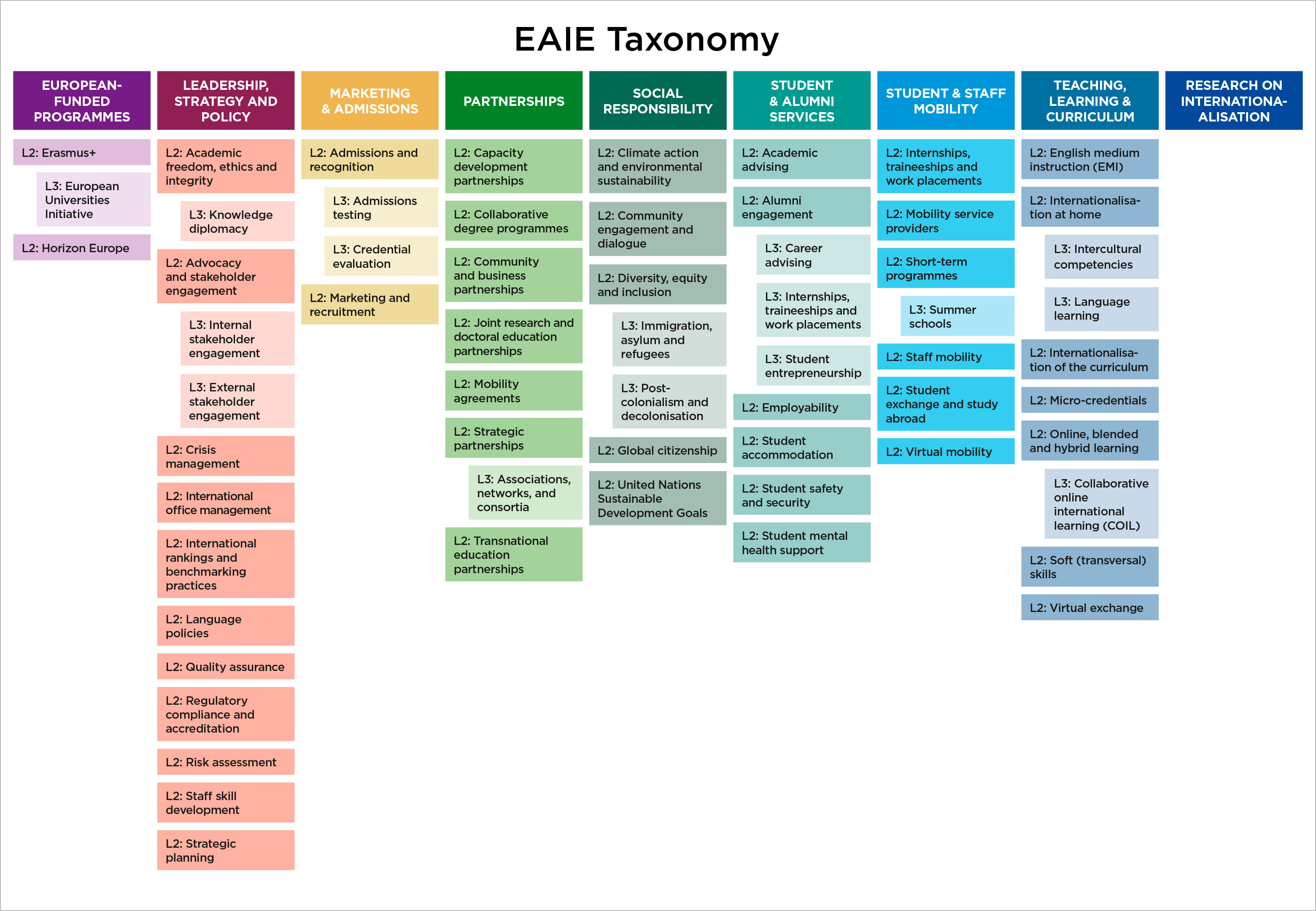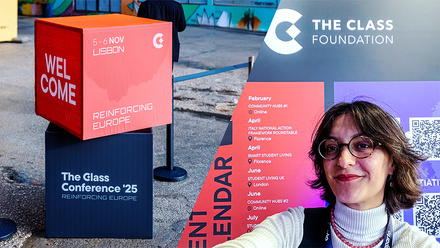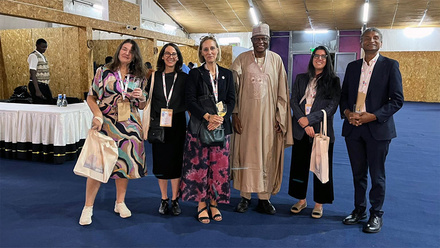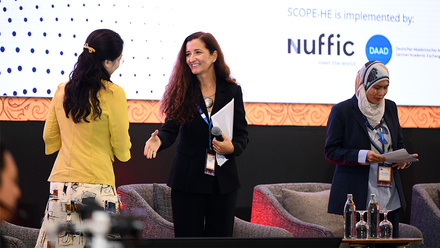Introducing the EAIE Taxonomy

The field of international higher education in Europe – and beyond – encompasses a wide range of issues and activities. Making sense of the full scope of those many different interests is challenging, but necessary.
Why? On the one hand, by clearly defining and explicitly naming what the work of the EAIE community is largely centred on, we can do a better job of serving the community’s needs for information and resources connected to those interests. This is an important and pragmatic objective. More fundamentally, however, by undertaking a systematic process that builds explicitly on broad community input to define the scope of the field, we contribute substantively to the ongoing effort to define what internationalisation is, what it encompasses in its current form and how the community of professionals undertaking this work conceives of its various parts. This is a significant contribution, given the ongoing debates about how exactly to define internationalisation in higher education, the multi-faceted nature of the field, and its unique and varied position across the landscape of higher education policy and practice in Europe and elsewhere.
Crafting a picture of a full ‘domain’ of professional practice is easier said than done – but that is precisely what the EAIE set out to do
Crafting a meaningful picture of a full ‘domain’ of professional practice is easier said than done, of course, but that is precisely what the EAIE set out to do in 2021, when the ambitious EAIE Taxonomy project was launched. Now in 2024, the taxonomy serves as the backbone for the EAIE’s content development strategy. Following positive feedback from the EAIE community, the scope of the application of the taxonomy has been widened and it has been used as a guide to help inform the new volunteer committee structure that will be implemented this year.
It can also provide food for thought for others around the world seeking new insight into the key constituent parts that define internationalisation in practice today. So, what is the EAIE Taxonomy and how did it come to be? Read on for the full story!
What exactly is a taxonomy?
A taxonomy is a system for organising and describing content. It ideally consists of a relatively small number of broad and accommodating ‘level one’ (L1) categories under which the entirety of a domain can be captured. Within each L1 category, there may be a number of more specific ‘level two’ (L2) and ‘level three’ (L3) terms that more specifically reflect what the various aspects of the domain address.
A thoughtfully developed taxonomy should be stable over a reasonable period of time – say, five to seven years – and should avoid including terms with short lifespans (ie those that are currently considered a ‘hot’ topic but may not stand the test of time). For the constantly evolving field of internationalisation, this is an important consideration. Recognising that new developments are imminent, which will inevitably introduce new priorities and potentially overshadow past developments, focusing on terminology that is specific enough to be meaningful but flexible enough to allow for changing circumstances over time is key.
Why an EAIE taxonomy?
The EAIE Taxonomy project was initiated to address several longstanding challenges faced by the Association in relation to the content – such as conference sessions, trainings and publications – that it produces and makes available to members and other users.
Notably, the categories and terms used to organise our content were decidedly inconsistent and ad hoc. For example, one list of categories might be used to describe the scope of our blogs and podcasts, while another could be used to organise our conference sessions, and yet another might frame the range of in-house trainings offered by the EAIE. Under these circumstances, external users searching our website or accessing our library could not count on a predictable organising principle for our content, making resources difficult to find. In parallel, because of the inconsistency of terms used to categorise our material, the EAIE itself could not easily track the extent to which different topics were being covered in the content we offer.
A smart, stable taxonomy helps improve content searchability and usability by external audiences. It also allows the EAIE to do more effective content planning, to better assess levels of interest across different topics presented in the content we produce, and to personalise content suggestions for users. In order to better meet the needs of stakeholders relying on resources from the EAIE, a more systematic approach – ie, a carefully crafted taxonomy, fit for purpose – was required.
How was the EAIE Taxonomy created?
The EAIE Taxonomy project was led by a taxonomy expert, with wide experience in guiding organisations around the world through an established taxonomy development process. The work consisted of several phases over multiple months in 2021 and 2022. It included an in-depth analysis of a broad array of EAIE materials and ‘artifacts’, as well as a review of existing taxonomies and key terminology in use across the international education field at large. Focus groups, user interviews and two large-scale, online testing activities involving several hundred EAIE community volunteers were also undertaken.
The online testing activities – referred to as ‘card sorting exercises’ – asked users to group terms identified from the previous phases of the taxonomy research process into categories that made sense to them. It also invited users to indicate where terms or categories were unfamiliar, and to suggest ways to fill any perceived gaps in the draft taxonomy. The combination of expert guidance, careful environmental scanning and wide user testing ensured a high level of confidence in a robust outcome for the taxonomy building exercise.
Bringing the EAIE Taxonomy to life
This dynamic process resulted in what today stands as the EAIE Taxonomy. What this means in practice is that the EAIE is committed to focus on nine main content areas, which are indicated as L1 items in the taxonomy image below. Sub-terms (L2s and L3s) have been identified for most of these categories, which provide more detailed indications of the topics and issues that the main categories will address.

While the EAIE Taxonomy has been actively embedded in the content development work of the Association since 2023, a new committee structure will be introduced this year that will further reinforce and align the way that the EAIE understands the scope of the field and acts on that knowledge.
This is a very exciting moment for the EAIE, as it institutionalises its first-ever systematic mapping exercise of the field into a comprehensive framework for content development. This will offer important benefits for the development and curation of the EAIE’s many products and services – from conference sessions to trainings, to publications, podcasts and more – ideally ensuring excellent balance, scope and relevance to a wide and diverse audience across our community. It will also hopefully energise ongoing conversations about internationalisation’s scope and focal points, ie how we define and frame the edges of our field. Equally, given the uniquely systematic and community-based processes that were employed to generate the new taxonomy, the EAIE will ideally continue to rely on innovative processes to refine and enhance our vision and understanding of internationalisation, directly aligned with the perspectives of the professionals who work in this field every day.
Who knew that a taxonomy – something most of us arguably have little experience with in our daily lives in international higher education – could generate such excitement and impact? But excitement and impact are precisely what we expect from our work with the new EAIE Taxonomy. We look forward to bringing this work to life with you and for you across 2024 and beyond!






